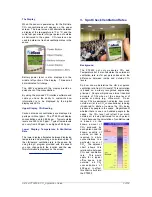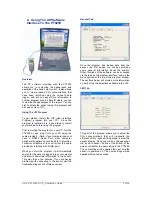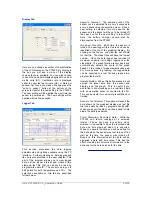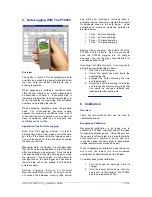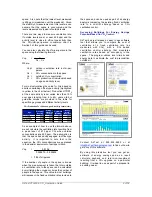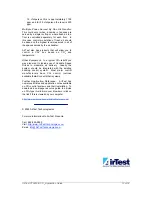
AirTest PT9250 & CO
2
Application Guide
11 of
12
•
Check air intakes on rooftops to ensure flue
exhausts from kitchen or furnace vents are
not being drawn into air intakes.
•
Use CO
2
to check for spillage of combustion
flues at water heaters or furnaces.
•
Check the effectiveness of commercial
ventilation systems in removing combustion-
related CO
2
.
Odor Control In Garages:
In parking garages, bus garage and fire halls
carbon monoxide (CO) or nitrogen dioxide (NO
2
)
is often used to control ventilation. However due
to the effectiveness of catalytic converters much
less CO is now produced by cars and trucks. In
some cases combustion fumes may build up to
the point where there is no CO or NO
2
danger,
however odors associated with combustion are
noticeable and unpleasant. This is also a
common problem with diesel vehicles that
produce little CO but numerous other particulates
and smelly contaminants.
In many cases, odor perception of combustion
fumes will correspond to a CO
2
level. You can
use the PT9250 to determine the level of odor
perception in a facility. A permanently installed
CO
2
monitor in the space can then use this
threshold CO
2
level to activate fans to control
odors related to vehicle combustion.
Building Commissioning:
Building Commissioning is becoming common
practice in many areas of the country. The
PT9250 has a number of applications to building
commissioning:
•
By calibrating the PT9250 to outside air or a
known source, calibration of
C O
2
sensors
for ventilation control can be quickly
checked.
•
If the space is occupied during the
commissioning period, ventilation levels in
each zone can be checked and compared
with design requirements.
Building Trouble Shooting:
Unusually high or low CO
2
levels in an occupied
space may indicate the malfunctioning of
mechanical equipment serving the space. For
example:
•
A difference in measurements of CO
2
between a space and a ceiling return plenum
may reflect excessive supply air duct
leakage into the plenum.
•
Calculation of percentage of outside air in an
air handler can be performed using a
process identical to the differential
temperature method, except substituting CO
2
levels measured.
•
Determine if ventilation systems are
delivering adequate fresh air to a particular
zone based on its current occupancy.
•
Improperly adjusted, or broken fresh air
dampers can often be identified if unusually
high or low levels occur within a space
during occupied periods.
•
Periodic day-long data-logging of a major
occupied space or floor can give a good
indication of occupancy hours. This
information can be used to reset timer
schedules on equipment.
Planning For A CO
2
Retrofit:
Ok, so you have measured CO
2
in the space and
used the AirTest Energy Analysis Program to
identify a significant potential for energy savings.
This section briefly describes what typically is
involved in a CO
2
retrofit.
Location Of Sensors:
Sensors should be
located in each major occupied space. Duct
mounting of sensors is not recommended for the
same reasons that temperature control does not
use in-duct sensing.
C o n t r o l
A l g o r i t h m :
Typically CO
2
concentrations are used to proportionately
modulate fresh air to the space. There are three
components to a control strategy:
1)
Minimum Ventilation Rate:
This is a low
level of ventilation provided to the space
during all occupied hours. Since CO
2
is
primarily related to people, this minimum rate
provides ventilation for non-occupant related
contaminants such as off gassing from
furniture and carpets. As a rule of thumb this
rate should be 30% of the Design ventilation
rate (Design rate = Design Occupancy X
Target cfm/person rate).
2)
Start Of Control
: Modulation of the air
delivery to the space should begin 100 ppm
to 150 ppm above outside concentrations
(e.g. 500-550 ppm).
3)
Upper Control Point:
The algorithm should
be designed so that the Design Ventilation
Rate (defined in 1) above), is provided when
the CO
2
concentration equal to the target
cfm/person ventilation rate is reached. For



